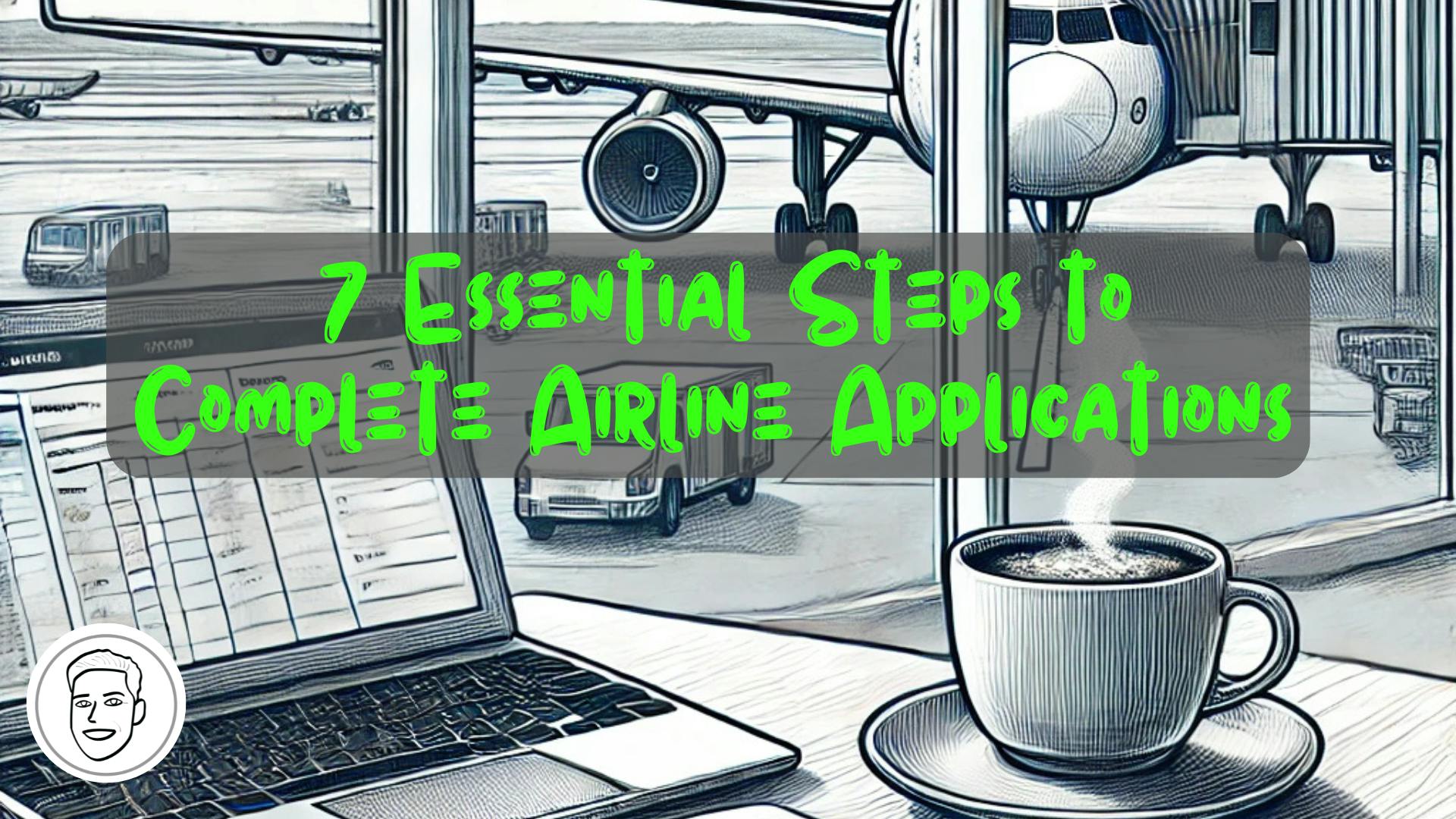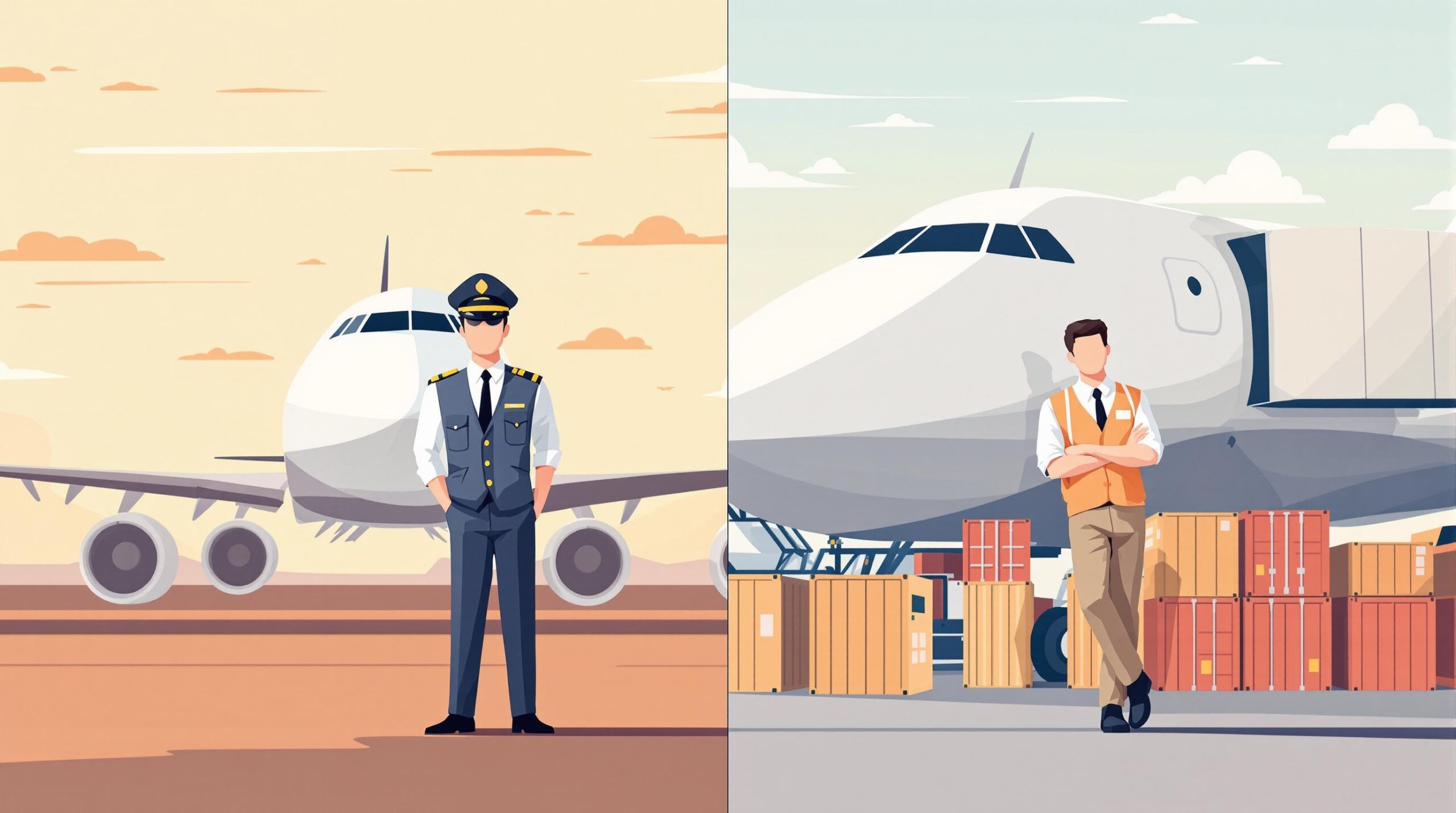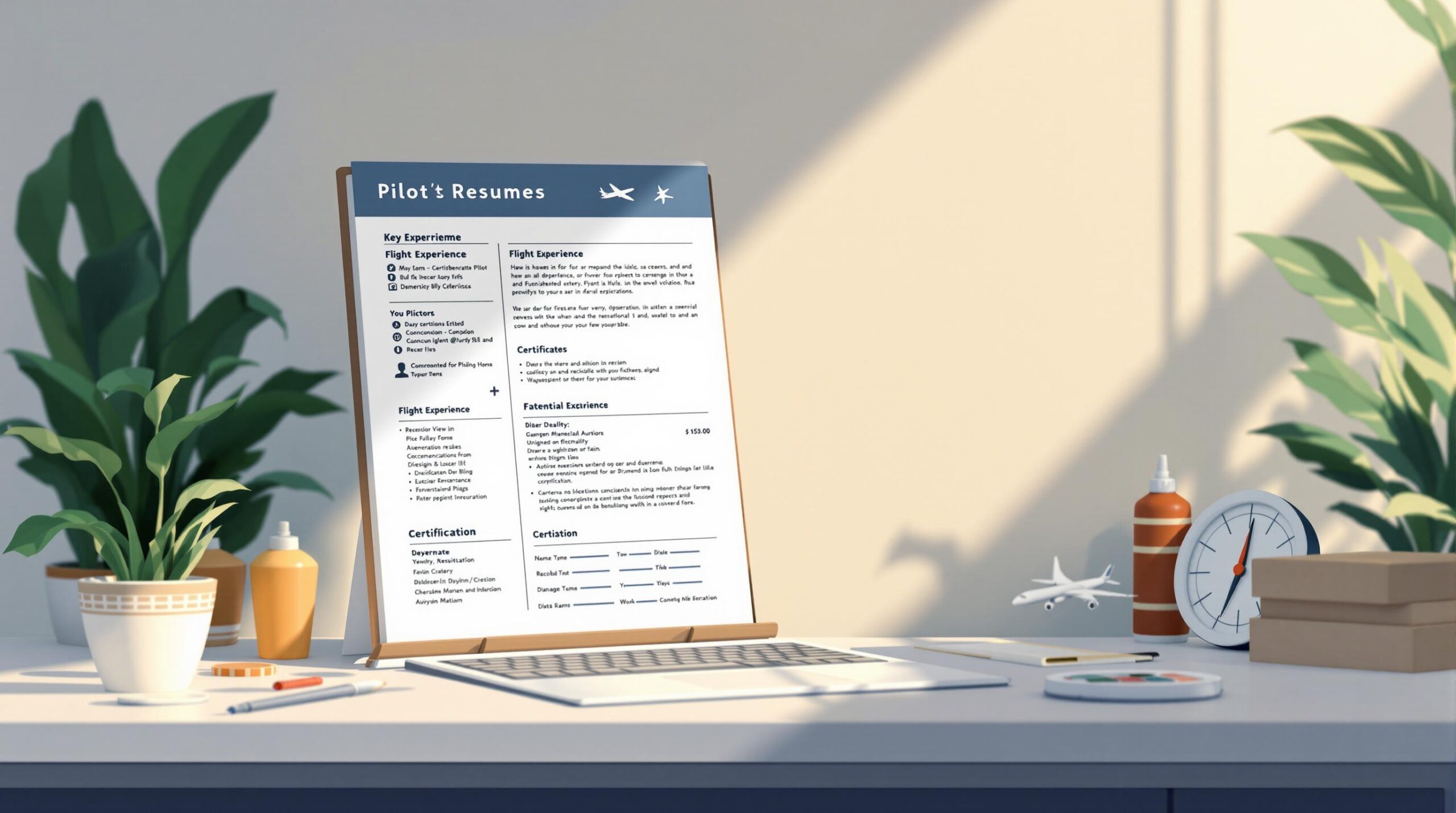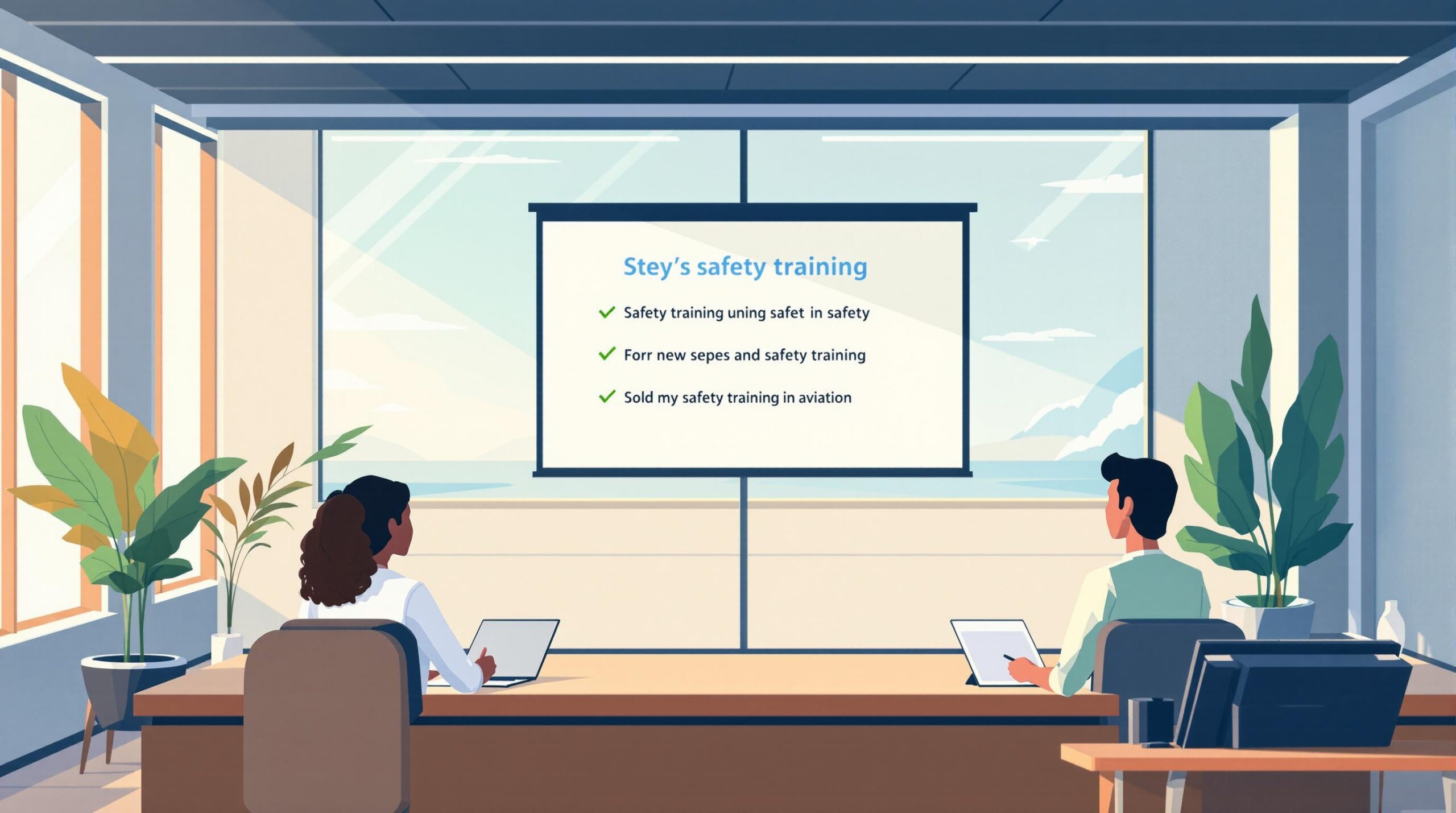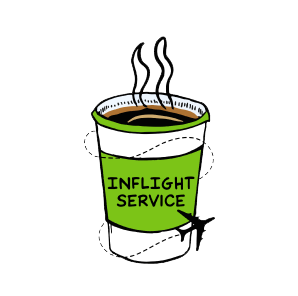Want to become an airline pilot? Here’s a quick guide to help you navigate the process:
- Research Airline Requirements: Meet the basics like 1,500 flight hours, ATP certification, and a bachelor’s degree (preferred by major airlines). Check specific airline needs like recent flight experience or turbine time.
- Gather Certifications & Documents: Keep licenses (Private, Instrument, Commercial, ATP) and flight logs accurate and up to date. Use digital tools to organize them.
- Polish Your Resume & Cover Letter: Highlight flight hours, certifications, and key skills. Tailor your application to each airline’s preferences.
- Network & Use Industry Resources: Attend job fairs, conferences, and join online aviation communities to connect with recruiters and mentors.
- Prepare for Interviews & Tests: Practice technical, behavioral, and simulator assessments. Brush up on regulations, decision-making, and leadership skills.
- Pass Medical Exams: Obtain a First-Class Medical Certificate. Ensure vision, hearing, and overall health meet FAA standards.
- Complete Airline Training: After hiring, finish onboarding, simulator sessions, and background checks.
Quick Comparison of Key Requirements
| Requirement | Regional Airlines | Major Airlines |
|---|---|---|
| Flight Hours | 1,500+ | 1,500+ (1,000 turbine preferred) |
| Degree | Not always required | Bachelor’s preferred |
| Certifications | ATP, Medical Certificate | ATP, Medical Certificate |
| Networking Importance | High | Very High |
Pro Tip: Use tools like Pilot Pathfinder to track your progress and simplify applications. Focus on details, stay organized, and meet all requirements to stand out.
Related video from YouTube
1. Research Airline Requirements and Define Career Goals
Want to become an airline pilot? You’ll need to meet some specific requirements. Take United Airlines – they want pilots with 1,500 hours of total flight time. They prefer 1,000 hours in fixed-wing turbine aircraft and at least 100 hours of recent flying within the last year.
Set Clear Career Goals
Your first big decision? Choose between regional and major airlines. Here’s the deal: Regional carriers might get you into the captain’s seat faster. Major airlines? They offer better perks – think international flights and bigger paychecks. Just remember: You need to be at least 23 years old, and the big airlines love to see that bachelor’s degree.
"With the pilot shortage expected to peak soon, qualified applicants who meet strict requirements have a unique advantage", notes Bryan from Pilot Pathfinder, emphasizing the importance of strategic career planning.
Learn About Airline Requirements
Let’s talk about what airlines look for beyond the basics. Your background needs to be squeaky clean. Got a felony? That’s usually a deal-breaker. Misdemeanors or DUIs? Airlines will look at these case by case.
Here’s what you’ll need:
| What You Need | Details | What to Know |
|---|---|---|
| Education | Bachelor’s degree | Big airlines won’t budge on this |
| Age | 23+ years | No exceptions |
| Flight Hours | 1,500 minimum | Recent experience counts |
| Medical | First Class Medical Certificate | Eyes must be 20/20 (glasses OK) |
Don’t forget your paperwork – you’ll need your Commercial Pilot Certificate, Instrument Rating, and ATP Certificate all up to date.
Pro tip: Use tools like Pilot Pathfinder to keep track of everything. It makes staying on top of each airline’s requirements way easier.
2. Collect Certifications and Key Documents
Getting your paperwork right can make or break your airline application. Big carriers like United Airlines won’t even look at your application if you’re missing any required documents.
Understand Education and Licensing Needs
The ATP Certificate is what separates hobby pilots from the pros.
"The ATP Certificate is non-negotiable for airline pilots. It’s the gold standard that separates recreational pilots from professionals", explains Bryan from Pilot Pathfinder, emphasizing the importance of proper certification planning.
Here’s what you need to fly for an airline:
| Certification | What You Need to Do |
|---|---|
| Private Pilot License | Pass written test and checkride |
| Instrument Rating | Show you can fly by instruments |
| Commercial License | Master advanced flying skills |
| ATP Certificate | Clock 1,500 hours, be 23+ years old |
After getting your certs, you’ll need to focus on keeping perfect flight records.
Keep Flight Logs Accurate and Organized
Think of your logbook as your flying resume – airlines will check every single entry. Using digital tools helps you avoid mistakes and keeps everything in order.
Your logs must show:
- At least 1,000 hours in fixed-wing turbine aircraft and 100 hours in the last year
- Your cross-country flights
- Time spent flying at night
- Hours flying by instruments
Airlines look at these numbers closely to make sure you meet their safety standards and have enough recent experience. They won’t take chances with pilots who can’t prove their flight time.
3. Build and Polish Your Application Materials
Getting your application materials right can make or break your chances of landing that dream pilot job. Here’s how to make your application stand out from the crowd.
Write a Professional Resume and Cover Letter
Your resume and cover letter are your ticket to getting noticed. Put your best foot forward by placing your flight experience and certifications where they’ll catch the recruiter’s eye – right at the top of your resume. Focus on the numbers that matter: flight hours, types of aircraft you’ve handled, and specific roles you’ve mastered.
"A well-structured resume that clearly displays your ATP certification and flight hours front and center can make the difference between getting an interview or being overlooked", explains Bryan from Pilot Pathfinder, emphasizing the importance of document organization.
Here’s what your aviation resume needs to shine:
| Section | What to Include | Why It Matters |
|---|---|---|
| Certifications | ATP, Type Ratings, Medical Certificate | Shows legal qualifications |
| Flight Experience | Total Hours, Aircraft Types, Recent Activity | Demonstrates practical expertise |
| Education | Aviation Degree, Training Programs | Shows theoretical knowledge |
| Special Skills | CRM Experience, Language Proficiency | Highlights additional value |
Make your resume work harder by matching your skills and experiences to what the airline values most. Once you’ve nailed your resume and cover letter, double-check those flight logs – they need to be spotless.
Use Tools to Organize Logbooks
These days, digital logbooks aren’t just nice to have – they’re must-haves for airline applications. Modern logbook tools pack some serious punch:
- They crunch the numbers for you (PIC, SIC, cross-country hours)
- Keep your flight records safe in the cloud
- Spit out your data in whatever format airlines want
Pilot Pathfinder takes your flight hours and packages them exactly how each airline wants to see them. Their system connects straight to your logbook, so you can show off your experience in the right format without breaking a sweat.
sbb-itb-de05b1b
4. Use Networking and Industry Resources
Want to boost your chances of landing that dream airline job? Get out there and meet people who matter.
Major airlines run recruitment events where you can chat with hiring managers in person. The Air Line Pilots Association (ALPA) puts together job fairs that bring multiple airlines together. These events aren’t just about finding jobs – they’re perfect for getting the inside scoop on what different airlines are really like.
Think of networking as building real relationships, not just collecting business cards. When you show up at these events, you’re not just another face in the crowd – you’re showing airlines that you mean business.
"Professional connections made at industry events often lead to mentorship relationships that can guide pilots through the application process", notes Bryan from Pilot Pathfinder, highlighting how networking can provide invaluable insider knowledge.
Here’s what smart networking looks like in action:
| What to Do | What You’ll Get |
|---|---|
| Career Fairs: Talk to recruiters | Direct feedback on your application |
| Industry Conferences: Mix and mingle | Long-term industry contacts |
| ALPA Events: Tap into union resources | Expert guidance on your career path |
Join Online Communities and Platforms
These days, your online presence matters just as much as showing up in person. Airlines keep their eyes on digital platforms to post jobs and check out potential candidates. Jump into professional forums, follow airline career pages, and get active in industry discussions. Pro tip: Set up job alerts so you’re not the last to know when your dream position opens up.
Build your network now, and you’ll walk into those interviews feeling ready to tackle any challenge that comes your way.
5. Prepare for Interviews and Skills Assessments
Getting ready for airline evaluations? Let’s break down what you need to know to stand out.
Succeed in Technical and Behavioral Interviews
Airlines want to see more than just your knowledge of aviation rules – they’re looking at how you think and act in the cockpit. Technical interviews put your expertise to the test, from knowing FAR/AIM regulations to handling tricky situations in the air.
Here’s what you’ll face at major airlines:
| Assessment Area | What to Review | Common Questions |
|---|---|---|
| Technical Knowledge | FAR/AIM regulations, systems operations | Aircraft limitations, emergency procedures |
| Decision Making | Past flight experiences, CRM scenarios | Weather diversions, crew conflicts |
| Leadership Skills | Command presence, crew management | Resource allocation, emergency response |
"The key to success in airline interviews is demonstrating both technical competence and sound judgment", notes Bryan from Pilot Pathfinder. "Candidates who can clearly articulate their decision-making process while showing deep technical knowledge consistently perform better."
Prepare for Cognitive and Psychometric Tests
Think you’ve got what it takes to join an airline crew? These tests will help prove it. Airlines use cognitive and psychometric assessments to see how well you’ll fit into their team and handle pressure in the cockpit.
What to focus on? Build your skills in spatial awareness, multitasking, and brush up on math and physics basics. Taking sample tests helps you know what to expect and keeps surprises to a minimum.
Get Ready for Simulator Tests
This is where the rubber meets the road – or rather, where your skills meet the simulator. Airlines use these tests to see how well you fly under pressure and make decisions in tough situations.
Your simulator test will check how well you handle standard procedures, tackle emergencies, work with your crew, and deal with bad weather. Think of it as your chance to show everything you’ve learned in action. Practice these scenarios until they become second nature – you’ll thank yourself when test day comes.
6. Complete Medical Exams and Final Steps
Get a First-Class Medical Certificate
Want to fly for airlines? You’ll need to prove you’re in top shape. The FAA requires pilots to get a First-Class Medical Certificate that checks everything from your eyesight to your heart health.
Here’s what you need to know: Your vision must be 20/20 (glasses or contacts are OK), you need good hearing, and your heart needs to be healthy. You can book your exam with an FAA-approved Aeromedical Examiner (AME) right on the FAA website.
Keep in mind: If you’re under 40, you’ll need to renew every year. Over 40? Plan for checkups every 6 months.
| Health Check | What They Look For | How Often |
|---|---|---|
| Vision | 20/20 (OK with glasses/contacts) | 6 months (under 40) |
| Hearing | Can you chat normally from 6 feet away? | 6 months (over 40) |
| Heart Health | Specific health standards | Regular checks |
| Color Vision | Must pass the test | First exam only |
"The First-Class Medical Certificate is essential for flying professionally", explains Dr. James Thompson, Senior Aviation Medical Examiner at the FAA.
Finish Onboarding and Training
Got your medical certificate? Next up is the airline’s training program. You’ll dive into ground school, practice in simulators, and go through background checks. Big airlines typically run longer training programs than regional ones.
You’ll learn company rules, specific aircraft operations, and undergo both background and drug screening. Pro tip: Stay on top of your paperwork and requirements – it’ll help you avoid getting stuck in application limbo. Once you wrap up these steps, you’ll be ready to take on the responsibilities of an airline pilot.
Conclusion: Final Steps for a Strong Application
"United is on a path towards becoming the best airline in the history of aviation and our commitment to hiring the most talented and diverse group of pilots is at the forefront of our efforts."
With airlines scrambling to fill cockpit seats and a pilot shortage expected to peak soon, you’ve picked the perfect time to start your airline pilot career. Your success boils down to solid prep work, being a pro, and nailing the details in your application.
Smart pilots use digital tools to speed things up – they’ll auto-fill those tedious forms and keep your logbook data organized. This comes in super handy when you’re juggling applications to multiple airlines.
Here’s what makes applications stand out:
| What to Focus On | Key Points | Timing |
|---|---|---|
| Flight Hours | Quality Time in Recent Months | Past Year |
| Being Professional | Show Up On Time, Stay in Touch | Every Step |
| Paperwork | Keep Digital Files Ready | Always Current |
Top flight schools like ATP and Coast Flight Training offer direct paths to airline jobs. They hook you up with mentors, partner airlines, and ways to pay for training that won’t break the bank. Going this route can fast-track your journey to the flight deck.
Keep your digital files fresh – that means flight hours, certificates, and medical records. Need the exact requirements? Check out the earlier sections for the nitty-gritty on flight time and medical stuff.
Jump on this now – the tools and prep work you do today set you up for success tomorrow. Put in the work, mind the details, and that airline pilot seat could be yours sooner than you think.
FAQs
How to get hired by major airlines?
Want to land a job with a major airline? Here’s what you need to know about the requirements and application process.
"Pilots must be able to travel freely within the United States and without restriction to all countries the airline serves", states a major airline’s hiring requirement document.
Major airlines like United look for pilots with serious flight experience – you’ll need at least 1,500 flight hours under your belt. They’re especially interested in pilots with 1,000 hours of turbine time. To show you’re on top of your game, you should have logged 100 hours in the past year.
Your education and certifications matter too. While not always required, a bachelor’s degree gives you an edge. You must have:
- A valid ATP certification
- An FAA first-class medical certificate
- 20/20 vision (glasses or contacts are fine)
- Passing scores on hearing tests
The background check process is no joke. A felony conviction will knock you out of the running. DUIs and misdemeanors? They’ll look at those case by case.
Here’s a pro tip: Use Pilot Pathfinder to manage your applications. It connects with your logbooks and helps you juggle applications to multiple airlines at once. Just make sure all your certifications and medical paperwork are up to date – you don’t want paperwork issues slowing down your application.
